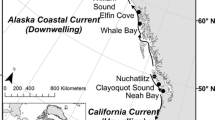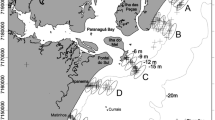Abstract
In a mesocosm study, somatic and otolith growth of six types of juvenile cyprinids differing in body size and body shape were studied in a low-intensity wave treatment and a no-wave control. Depending on fish type, somatic growth was either reduced by up to 60% or increased by up to 50% following exposure to the wave treatment. Somatic growth and otolith daily increment width (ODIW), the latter being used as a proxy for the fish energy turnover, were compared to reveal the effects of waves on the energy budget of the fish. Three different reaction types to waves, which correlated to the body morphology of the six fish groups, could be distinguished. Small and fusiform fish benefitted from low-intensity waves and showed higher somatic growth rates and greater ODIW in the wave treatment. In small, deep-bodied fish, growth and ODIW were reduced by waves. Finally, in larger fish with either a fusiform or deep-bodied shape, ODIW was decoupled from somatic growth, with larger ODIW in waves, but reduced somatic growth. These results show that low-intensity hydrodynamic stress is a much more important and complex habitat factor than previously assumed. It is concluded that hydrodynamic stress by waves should be accounted for in bioenergetic models and studies on habitat choice in littoral fish species.


Similar content being viewed by others
References
Armstrong JD, Fallon-Cousins PS, Wright PJ (2004) The relationship between specific dynamic action and otolith growth in pike. J Fish Biol 64:739–749
Barber MC, Jenkins GP (2001) Differential effects of food and temperature lead to decoupling of short-term otolith and somatic growth rates in juvenile King George whiting. J Fish Biol 58:1320–1330
Blake RW (2004) Fish functional design and swimming performance. J Fish Biol 65:1193–1222
Blanchet SG (2008) Competition, predation, and flow rate as mediator of direct and indirect effects in a stream food web. Oecologia 157:93–104
Boisclair D, Leggett WC (1989) The importance of activity in bioenergetics models applied to actively foraging fishes. Can J Fish Aquat Sci 46:1859–1867
Boisclair D, Tang M (1993) Empirical analysis of the influence of swimming pattern on the net energetic cost of swimming in fishes. J Fish Biol 42:169–183
Enders EC, Boisclair D, Roy AG (2004) The costs of habitat utilization of wild, farmed, and domesticated juvenile Atlantic salmon (Salmo salar). Can J Fish Aquat Sci 61:2302–2313
Felley JD (1984) Multivariate identification of morphological-environmental relationships within cyprinidae (Pisces). Copeia 1984:442–455
Fischer P, Eckmann R (1997a) Seasonal changes in fish abundance, biomass and species richness in the littoral zone of a large European lake, Lake Constance, Germany. Arch Hydrobiol 139:433–448
Fischer P, Eckmann R (1997b) Spatial distribution of littoral fish species in a large European lake, Lake Constance, Germany. Arch Hydrobiol 140:91–116
Flore L, Keckeis H (1998) The effect of water current on foraging behaviour of the rheophilic cyprinid Chondrostoma nasus (L.) during ontogeny: evidence of a trade-off between energetic gain and swimming costs. Regul Rivers Res Mgmt 14:141–154
Fulton CJ, Bellwood DR, Wainwright PC (2005) Wave energy and swimming performance shape coral reef fish assemblages. Proc R Soc B 272:827–832
Gabel F, Garcia X-F, Brauns M, Sukhodolov A, Leszinski M, Pusch MT (2008) Resistance to ship-induced waves of benthic invertebrates in various littoral habitats. Freshw Biol 53:1567–1578
Gabel F, Stoll S, Fischer P, Pusch MT, Garcia X-F (in press) Differential effects of wind and ship waves on predator-prey interactions between fish and benthic invertebrates: an experimental study. Oecologia
Gliwicz ZM, Jachner A (1992) Diel migrations of juvenile fish: a ghost of predation past or present? Arch Hydrobiol 124:385–410
Hanson PC, Johnson TB, Schindler DE, Kitchell JF (1997) Fish Bioenergetics 3.0 for Windows. University of Wisconsin, Sea Grant Institute, Madison
Hofmann H (2007) Characteristics and implications of surface gravity waves in the littoral zone of a large lake (Lake Constance). PhD thesis. University of Constance, Constance
Hofmann H, Lorke A, Peeters F (2008) The relative importance of wind and ship waves in the littoral zone of a large lake. Limnol Oceanogr 53:368–380
Huuskonen H, Karjalainen J (1998) A preliminary study on the relationships between otolith increment width, metabolic rate and growth in juvenile whitefish (Coregonus lavaretus L.). Arch Hydrobiol 142:371–383
Jackson DA, Peres-Neto PR, Olden JD (2001) What controls who is where in freshwater fish communities—the role of biotic, abiotic, and spatial factors. Can J Fish Aquat Sci 58:157–170
Keast A (1985) Development of dietary specializations in summer community of juvenile fishes. Environ Biol Fishes 13:211–224
Kottelat M, Freyhof J (2007) Handbook of European freshwater fishes. Publications Kottelat, Cornol
Krohn MM, Boisclair D (1994) Use of a stereo-video system to estimate the energy expenditure of free-swimming fish. Can J Fish Aquat Sci 51:1119–1127
Kundu PK, Cohen IM (2002) Fluid mechanics, 2nd edn. Academic Press, London
Langerhans RB (2008) Predictability of phenotypic differentiation across flow regimes in fishes. Integr Comp Biol 48:750–768
Lewin W-C, Okun N, Mehner T (2004) Determinants of the distribution of juvenile fish in the littoral area of a shallow lake. Freshw Biol 49:410–424
Liao JC (2007) A review of fish swimming mechanics and behaviour in altered flows. Phil Trans R Soc B 362:1973–1993
Lienesch PW, Matthews WJ (2000) Daily fish and zooplankton abundances in the littoral zone of Lake Texoma, Oklahoma–Texas, in relation to abiotic variables. Environ Biol Fishes 59:271–283
Ljunggren L, Sandström A (2007) Influence of visual conditions on the foraging and growth of juvenile fishes with dissimilar sensory physiology. J Fish Biol 70:1319–1334
MacKenzie BR, Miller TJ, Cyr S, Leggett WC (1994) Evidence for a dome-shaped relationship between turbulence and larval fish ingestion rates. Limnol Oceanogr 39:1790–1799
Marchaj CA (1988) Aero-hydrodynamics of sailing. International Marine Publ, Camden
Monismith SG, Fong DA (2004) A note on the potential transport of scalars and organisms by surface waves. Limnol Oceanogr 49:1214–1217
Mosegaard H, Svedäng H, Taberman K (1988) Uncoupling of somatic and otolith growth rates in Arctic char (Salvelinus alpinus) as an effect of differences in temperature response. Can J Fish Aquat Sci 45:1514–1524
Neverman D, Wurtsbaugh WA (1994) The thermoregulatory function of diel vertical migration for a juvenile fish, Cottus extensus. Oecologia 98:247–256
Ohlmer W (1964) Untersuchungen über die Beziehungen zwischen Körperform und Bewegungsmedium bei Fischen aus stehenden Binnengewässern. Zool Jahrb Anat 81:151–240
Pierce CL (1994) Littoral fish communities in Southern Quebec lakes: relationship with limnological and prey resource variables. Can J Fish Aquat Sci 51:1128–1138
Rennie MD, Collins NC, Shuter BJ, Rajotte JW, Couture P (2005) A comparison of methods for estimating activity costs of wild fish populations: more active fish observed to grow slower. Can J Fish Aquat Sci 62:767–780
Rossier O, Castella E, Lachavanne J-B (1996) Influence of submerged aquatic vegetation on size class distribution of perch (Perca fluviatilis) and roach (Rutilus rutilus) in the littoral zone of Lake Geneva (Switzerland). Aquat Sci 58:1–14
Rothschild BJ, Osborn TR (1988) Small-scale turbulence and plankton contact rates. J Plankton Res 10:465–474
Savino JF, Stein RA (1989a) Behaviour of fish predators and their prey: habitat choice between open water and dense vegetation. Environ Biol Fish 24:287–293
Savino JF, Stein RA (1989b) Behavioural interactions between fish predators and their prey: effects of plant density. Anim Behav 37:311–321
Sims DW, Wearmouth VJ, Southall EJ, Hill JM, Moore P, Rawlinson K, Hutchinson N, Budd GC, Righton D, Metcalfe JD, Nash JP, Morritt D (2006) Hunt warm, rest cool: bioenergetic strategy underlying diel vertical migration of a benthic shark. J Anim Ecol 75:176–190
Stoll S, Fischer P, Klahold P, Scheifhacken N, Hofmann H, Rothhaupt K-O (2008) Effects of water depth and hydrodynamics on the growth and distribution of juvenile cyprinids in the littoral zone of a large pre-alpine lake. J Fish Biol 72:1001–1022
Stoll S, Hofmann H, Fischer P (2010) Effect of wave exposure dynamics on gut content mass and growth of young-of-the-year fishes in the littoral zone of lakes. J Fish Biol 76:1714–1728
Tonn WM, Magnuson JJ (1982) Patterns in the species composition and richness of fish assemblages in northern Wisconsin lakes. Ecology 63:1149–1166
Webb PW (2002) Control of posture, depth, and swimming trajectories of fishes. Int Comp Biol 42:94–101
Werner EE, Hall DJ (1988) Ontogenetic habitat shifts in bluegill: the foraging rate-predation risk trade-off. Ecology 69:1352–1366
Werner EE, Hall DJ, Laughlin DR, Wagner DJ, Wilsmann LA, Funk FC (1977) Habitat partitioning in a freshwater community. J Fish Res Board Can 34:360–370
Wolter C, Arlinghaus R (2003) Navigation impacts on freshwater fish assemblages: the ecological relevance of swimming performance. Rev Fish Biol Fish 13:63–89
Wolter C, Arlinghaus R, Sukhodolov A, Engelhardt C (2004) A model of navigation-induced currents in inland waterways and implications for juvenile fish displacement. Env Mgmnt 34:656–668
Wright PJ (1991) The influence of metabolic rate on otolith increment width in Atlantic salmon parr, Salmo salar L. J Fish Biol 38:929–933
Wright PJ, Fallon-Cousins P, Armstrong JD (2001) The relationship between accretion and resting metabolic rate in juvenile Atlantic salmon during a change in temperature. J Fish Biol 59:657–666
Yamamoto T, Ueda H, Higashi S (1998) Correlation among dominance status, metabolic rate and otolith size in masu salmon. J Fish Biol 52:281–290
Acknowledgments
We thank J. Koeritzer, A. Meriac, T. Merz, O. Okle, M. Schmid and M. Wolf for help during the mesocosm experiment and lab work and P. Hirsch and H. Hofmann for fruitful discussions. R. Eckmann and W. N. Probst provided valuable comments on earlier versions of this manuscript. This study was completed within the Collaborative Research Centre 454 “Littoral Zone of Lake Constance” and was financially supported by the German Research Foundation (DFG) and a personal grant to S.S. by the German National Academic Foundation. The experiments comply with the current laws of Germany, where this study was performed.
Author information
Authors and Affiliations
Corresponding author
Additional information
Communicated by Craig Osenberg.
Rights and permissions
About this article
Cite this article
Stoll, S., Fischer, P. Three different patterns of how low-intensity waves can affect the energy budget of littoral fish: a mesocosm study. Oecologia 165, 567–576 (2011). https://doi.org/10.1007/s00442-010-1793-z
Received:
Accepted:
Published:
Issue Date:
DOI: https://doi.org/10.1007/s00442-010-1793-z




